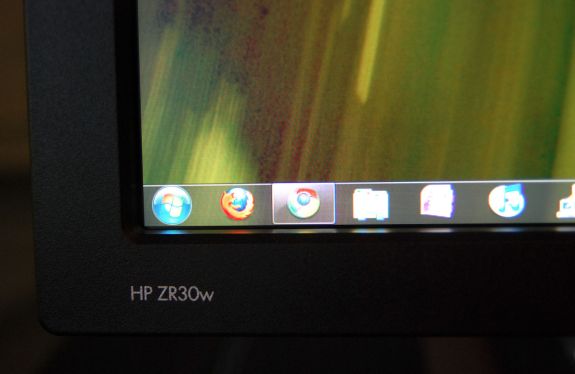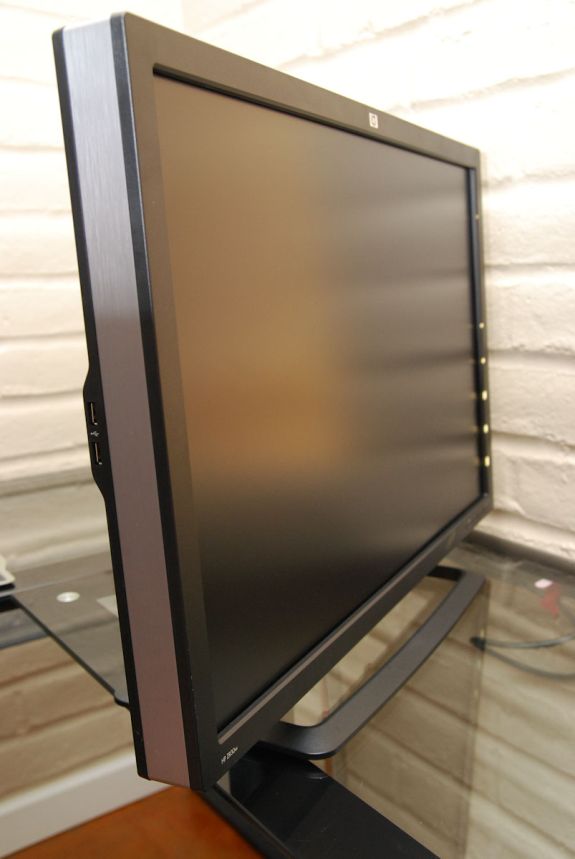A New 30" Contender: HP ZR30w Review
by Brian Klug on June 1, 2010 6:30 PM EST
Opining for an OSD
As I mentioned before, there’s no OSD to speak of. The only options exposed to users are input selection, brightness, and dynamic contrast. A blue LED at right flashes three times when you’ve reached the upper or lower brightness limits, and flashes four times when dynamic contrast is turned on, once when turned off. The LED is off when the display is in operation, and amber when in standby. The rest is up to you.
Spartan Scaling Selections
I also already touched on scaling which appears to be pretty barebones for reasons discussed earlier. You can pixel double by going with 1280x800, or go for native, or choose another resolution and everything upscaled with some smudging. There's no 1:1 option, or any options whatsoever. Honestly, I can’t think of any reasons why you wouldn’t drive an LCD at anything other than native resolution. The dot pitch of the ZR30w is fabulous at 0.250 mm, if you’re paying for those pixels, use them, then use DPI controls in the operating system if text and UI is too small. The ZR30w does scale other aspect ratios that I tested properly, but don't expect too much. Honestly it still makes no sense to drive a display this high resolution at anything but native.
Final Thoughts
The 30” segment of the LCD market demands the best of the best. It’s indisputably the ring in which every manufacturer wages battle with its flagship monitor. Solid execution here usually translates to solid performance for smaller size panels in the same lineup. Suffice it to say that HP’s 30 inch ZR series successor to the LP3065 doesn’t disappoint.
Spartan Scaling Selections
I also already touched on scaling which appears to be pretty barebones for reasons discussed earlier. You can pixel double by going with 1280x800, or go for native, or choose another resolution and everything upscaled with some smudging. There's no 1:1 option, or any options whatsoever. Honestly, I can’t think of any reasons why you wouldn’t drive an LCD at anything other than native resolution. The dot pitch of the ZR30w is fabulous at 0.250 mm, if you’re paying for those pixels, use them, then use DPI controls in the operating system if text and UI is too small. The ZR30w does scale other aspect ratios that I tested properly, but don't expect too much. Honestly it still makes no sense to drive a display this high resolution at anything but native.
Final Thoughts
The 30” segment of the LCD market demands the best of the best. It’s indisputably the ring in which every manufacturer wages battle with its flagship monitor. Solid execution here usually translates to solid performance for smaller size panels in the same lineup. Suffice it to say that HP’s 30 inch ZR series successor to the LP3065 doesn’t disappoint.
We would’ve liked to see just a bit more color accuracy, but the tradeoff for a dramatically bigger gamut is a good one to make. The ZR30w blew past the advertised 99% of AdobeRGB, coming in at just over 111% of the volume. It’s important to note that HP likely means coverage overlap of 99%, which the ZR30w does meet. But heck, having a volume bigger than the AdobeRGB volume is more notable. In person, the ZR30w is impressive all around. It’s bright, contrasty, and has colors that put my daily use monitors and others I’ve got laying around to shame; not an easy thing to do.
At an MSRP of $1,299, the ZR30w is priced aggressively and below its predecessor and competition. If you don’t mind lacking an extra DVI port, the increase in gamut volume is a notable difference. It’s likely that both lack of an OSD as well as accessory VGA, HDMI, component or composite inputs is related to the lack of a compatible control IC. Instead, there’s likely a simple scaler so we see minimal processing lag for an IPS panel, and unfortunately minimal user control. This is a bold move on HP’s part to continue for a second generation, but likely keeps cost and input processing lag low.
At an MSRP of $1,299, the ZR30w is priced aggressively and below its predecessor and competition. If you don’t mind lacking an extra DVI port, the increase in gamut volume is a notable difference. It’s likely that both lack of an OSD as well as accessory VGA, HDMI, component or composite inputs is related to the lack of a compatible control IC. Instead, there’s likely a simple scaler so we see minimal processing lag for an IPS panel, and unfortunately minimal user control. This is a bold move on HP’s part to continue for a second generation, but likely keeps cost and input processing lag low.
Interestingly enough, this is definitely the way that things are going for display controls, with a growing number offering DDC control as the exclusive option for tweaking settings. In practice, what HP offers with the front controls is almost all you need, so long as you can calibrate to your liking in software. Perhaps we might have gotten under a Delta E of 1.0 with some RGB sliders, but who’s to say?
The ZR30w is definitely a serious contender among 30” displays. It’s an attractive package that wows with above average color tracking, an impressive gamut, and a competitive price, but lacks some of the extra “accessory” inputs that consumers are starting to demand. That said, it looks like the ZR30w is a solid option if you’re looking for a 30” display with an unbeatable color gamut.












95 Comments
View All Comments
boe - Wednesday, June 2, 2010 - link
I've been waiting to buy some monitors for years as the 3008WFP had it's share of issues and Apple hasn't released a new LED backlit 30" yet.I'm looking forward to getting a couple of new monitors but not until some higher end models come out with a clear improvement over my 3007wfp's.
xismo - Wednesday, June 2, 2010 - link
I find it a bit dissapointing that you don't list the configuration this was tested on. For example I don't know the gpu the monitor was running on and therefore I wouldn't know whether the gpu had 10-bit support. It would be nice if you could try to add test of 10-bit support as well, how it performs with smooth gradients and so on. As you probably know not too many graphics cards support 10-bit, but all of the workstation class cards do, which I think is appropriate for testing with high end monitors.xismo - Wednesday, June 2, 2010 - link
After reading the comments I see there was a discussion about 10-bit support, sorry for not seeing that earlier. At least I'm not the only one concerned about this :) BTW 5870 does not have 10-bit support as almost all of the other gaming video cards. And using a mini displayport on a macbook pro will not make the geforce 330m have 10-bit support either. Displayport as well as dual link dvi are the only types of connection that are able to process 10-bit color, but you still need a matching video card. Any workstation card like quadro or firepro should be just fine. But yeah including how each monitor displays gradients would be a huge advantage for me, as this is one of the things I'm looking for in a new monitor.Brian Klug - Wednesday, June 2, 2010 - link
Hey there! Thanks for the comment, yeah I'm working on getting us either a workstation GPU or some other way (whole workstation) to really test the 10-bit aspect. It'll happen this week or next and then I'll update. I realized after posting that I forgot to make sure it was working over 10-bit. And you're right about the 5870-it doesn't have 10-bit support. Guess that's one of those arguments for a more expensive workstation version of the card!Cheers!
Brian Klug
awaken688 - Wednesday, June 2, 2010 - link
I'm surprised no one has really complained about the brightness limitation. For professional photographers and graphic artists (the target audience), this would be rough to have no way to see below 150nits as a real means to check for print accuracy. For some of our print shops, 100 nits is accurate to print.Brian,
Did you try adjusting the brightness via the video card as well? I have a monitor that on 0 brightness is still too bright, but I can then go into nVidia's control panel and lower the brightness using that to achieve the correct brightness or lower the RGB manually (which I understand isn't an option for this monitor). Just wondering. Nonetheless, this should at least be able to hit 120 nits for imaging professionals. Good article though. I like the monitor reviews for sure.
Soldier1969 - Wednesday, June 2, 2010 - link
Thanks for the review, not a bad price for a new 30 incher compared to other brands. Those people here that want 24" reviews those are a dime a dozen and for the poor. I had a 24" 1920 x 1200 monitor long before most did since 2007 when they cost a fortune. So glad I jumped to 2560 x 1600, gaming on them owns everything else out there! Blu ray looks fantastic! If youve never experienced computing on a 30 incher your missing out!kasakka - Thursday, June 3, 2010 - link
The lack of OSD is what kills this for me. I find that without it getting accurate colors is more difficult and if you want to also use the display for gaming, some games may totally ignore calibrated color profiles or software adjustments. The lack of a scaler is a bit annoying too, but since graphics cards can do that at least in Windows, it's not really a problem.Regarding inputs, I currently have a Dell 3008WFP and its gazillion inputs is a huge minus for me. I only need one DVI and one Displayport, so having to cycle thru all the useless inputs is annoying. More annoying is the 3008WFP's (and the 27" Dell U2711's) circa 5 second delay when swithing resolutions or inputs. But I guess I'll stick with the Dell until someone comes out with something better.
pmeinl - Thursday, June 3, 2010 - link
Does the AG coating of the ZR30 have this annoying sparkle effect like other current IPS panels (ex: U2410).Working on my two U2410 (programming, text processing) causes me eye strain.
pmeinl - Friday, June 4, 2010 - link
As some people do not see the sparkle problem, here is a thread with a picture of it:http://hardforum.com/showthread.php?t=1466914&...
B3an - Thursday, June 3, 2010 - link
So just to be clear... does this display do more colors than the Dell 3008?